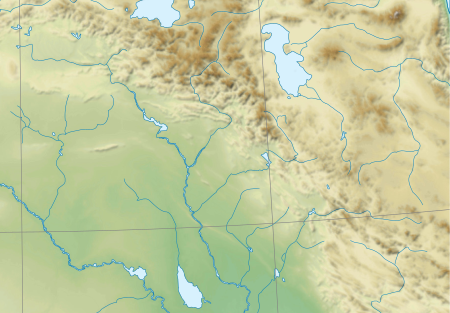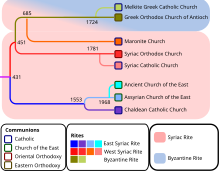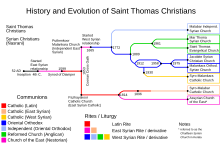lingvo.wikisort.org - Language
Hertevin is a dialect of Northeastern Neo-Aramaic originally spoken by Chaldean Catholics in a cluster of villages in Siirt Province in southeastern Turkey. Speakers of Hértevin Aramaic have emigrated mostly to the West, and are now scattered and isolated from one another. A few speakers remain in Turkey. The closest related language variety is Bohtan Neo-Aramaic.[2] Hertevin also shares many similarities with Turoyo.
| Hertevin | |
|---|---|
| ܣܘܪܬ Sôreth | |
| Pronunciation | [ˈhɛrtəvən], [ˈsorɛθ] |
| Native to | Turkey |
| Region | Siirt Province |
Native speakers | 1,000 (1999)[1] |
Language family | Afro-Asiatic
|
Writing system | Syriac (Madnhāyâ alphabet) |
| Language codes | |
| ISO 639-3 | hrt |
| Glottolog | hert1241 |
| ELP | Northern Northeastern Neo-Aramaic |
Origins
Hértevin was 'discovered' by linguist Otto Jastrow in 1970, and first described in publication by him two years later. His recordings of the language are available on Heidelberg University's Semitic Sound Archive.
The speakers of the Hértevin dialect of Neo-Aramaic are traditionally Chaldean Catholics. Their area of habitation in and around the village of Hertevin (called Hertevinler in Turkish and Härtəvən in Kurdish), near the town of Pervari in Siirt Province is at the very northeastern extreme of the area where Eastern Neo-Aramaic languages were traditionally spoken. Thus, Hértevin is a peripheral dialect that has developed quite differently from related languages.
All Hértevin speakers are bilingual in Kurdish, and many also speak other languages. The Syriac alphabet is used for writing, but almost no literature in the Hértevin dialect exists. Church liturgy is in Syriac.
Phonology
Its major phonetic feature is the loss of the voiceless velar fricative x, which has become a voiceless pharyngeal fricative, ħ. The original voiceless pharyngeal fricative has retained that pronunciation. In all the other dialects of eastern Neo-Aramaic the opposite is true: the voiceless pharyngeal fricative has been lost and merged with the voiceless velar fricative. /x/ does occur in loanwords to Hertevin.[citation needed] The [θ] and [ð] that occur in some other dialects of NENA merged back to [t] and [d].[3]
Another feature of Hértevin Neo-Aramaic is its set of demonstratives. As with other languages of the eastern group, Hértevin makes no distinction between 'this' and 'that', and uses a single set of pronouns to cover both meanings: āwa (m. sg.), āya (f. sg.) and āni (pl.). However, unlike the other languages, Hértevin has developed an emphatic form of these pronouns that indicates 'this one right here': ōhā, ēhā and anhī.
Although belonging to the eastern, or northeastern, group of Neo-Aramaic dialects, Hértevin shares some features with the Turoyo language, of the central group, originating from nearby Mardin Province.
| Labial | Dental/Alveolar | Palato- alveolar |
Velar | Uvular | Pharyngeal | Glottal | ||||||||||
|---|---|---|---|---|---|---|---|---|---|---|---|---|---|---|---|---|
| plain | emphatic | |||||||||||||||
| Stop / Affricate | p | b | t | d | tˤ | tʃ | dʒ | k | ɡ | q | ʔ | |||||
| Fricative | f | s | z | sˤ | ʃ | ʒ | x | (ɣ) | ħ | (ʕ) | h | |||||
| Nasal | m | n | ||||||||||||||
| Approximant | w | j | ||||||||||||||
| Trill | r | (rˤ) | ||||||||||||||
| Lateral | l | (lˤ) | ||||||||||||||
| Front | Central | Back | |
|---|---|---|---|
| High | i | u | |
| Mid | e | o | |
| Low | a |
- They are phonetically noted as long sounds [iː eː aː oː uː].
- /i/ and /u/ are phonetically slightly lowered as [i̞] and [u̞].
| Front | Central | Back | |
|---|---|---|---|
| High/Mid | [ɪ ~ e] | [ʊ ~ o] | |
| Low | [æ ~ ä] | ||
- /a/ can be raised to [ɐ] when preceding a pharyngeal /ħ/, and an unstressed [ä] can be heard as a more front [a] when preceding.
See also
- Aramaic language
- Assyrian Church of the East
- Assyrian Neo-Aramaic
- Chaldean Neo-Aramaic
- Syriac alphabet
- Syriac language
References
- Hertevin at Ethnologue (18th ed., 2015) (subscription required)
- THE STORY OF MEM U ZINE IN THE NEO-ARAMAIC DIALECT OF BOHTAN SE Fox - … LINGUISTICS PRESENTED TO GENE B. GRAGG, 2007 https://oi.uchicago.edu/sites/oi.uchicago.edu/files/uploads/shared/docs/saoc60.pdf#page=97
- Jastrow 1988, p. 6.
- Jastrow 1988, p. 3.
- Jastrow 1988, p. 10.
- Jastrow 1988, p. 15.
Further reading
- Jastrow, Otto (1988). Der neuaramäische Dialekt von Hertevin (Provinz Siirt) (in German). Otto Harrassowitz Verlag. ISBN 978-3-447-02767-0.
- Jastrow, Otto (1990). "Personal and Demonstrative Pronouns in Central Neo-Aramaic: A Comparative and Diachronic Discussion Based on Ṭūrōyo and the Eastern Neo-Aramaic Dialect of Hertevin". In Wolfhart Heinrichs (ed.). Studies in Neo-Aramaic. BRILL. pp. 89–103. doi:10.1163/9789004369535_009. ISBN 978-1-55540-430-7.
- Maclean, Arthur John (1895). Grammar of the dialects of vernacular Syriac: as spoken by the Eastern Syrians of Kurdistan, north-west Persia, and the Plain of Mosul: with notices of the vernacular of the Jews of Azerbaijan and of Zakhu near Mosul. Cambridge University Press, London.
- Takashina, Yoshiyuki. 1990. Some Remarks on Modern Aramaic of Hertevin. Journal of Asian and African Studies 40: 85-132.
- Takashina, Yoshiyuki (1990). "Two Residual Notes on Modern Aramaic of Hertevin". Orient. 26: 105–122. doi:10.5356/orient1960.26.105.
External links
На других языках
[de] Hertevin-neuaramäische Sprache
Hertevin ist eine neuaramäische Sprache, die zum nordöstlichen Zweig des Ostaramäischen gehört (siehe Aramäische Sprachen). Es wurde ursprünglich im Ort Hertevin und einigen umliegenden Dörfern in der Siirt-Provinz im Südosten der Türkei gesprochen. Die meisten Sprecher – traditionell chaldäische Katholiken – sind im Zuge der Verfolgung und Verdrängung der aramäischen Christen im 20. Jahrhundert emigriert und leben verstreut in vielen westlichen Ländern. Nur wenige sind noch in der Türkei geblieben. Die Gesamtzahl der Sprecher wird heute auf 1.000 geschätzt.[1] Hertevin wurde erst 1970 vom deutschen Semitisten Otto Jastrow „entdeckt“[2] und zwei Jahre danach in einer Publikation beschrieben.- [en] Neo-Aramaic dialect of Hertevin
[ru] Севернобохтанский язык
Севернобохтанский язык (хертевинский; Hértevin) — один из новоарамейских языков, распространённый ранее на юго-востоке Турции, на севере исторической области Бохтан. Наиболее известен диалект деревни Артувин (Хертевин), которая дала одно из названий всему языку. Эта деревня входила в группу нескольких деревень, располагавшихся недалеко от города Первари на востоке провинции Сиирт. Другие диалекты этого языка известны из других деревень той же провинции: Эрух (Дех), Азир, Тахрам, Ширван, Зокайит, Бейкент и из деревни Ачканис на западе соседней провинции Ван.Другой контент может иметь иную лицензию. Перед использованием материалов сайта WikiSort.org внимательно изучите правила лицензирования конкретных элементов наполнения сайта.
WikiSort.org - проект по пересортировке и дополнению контента Википедии





